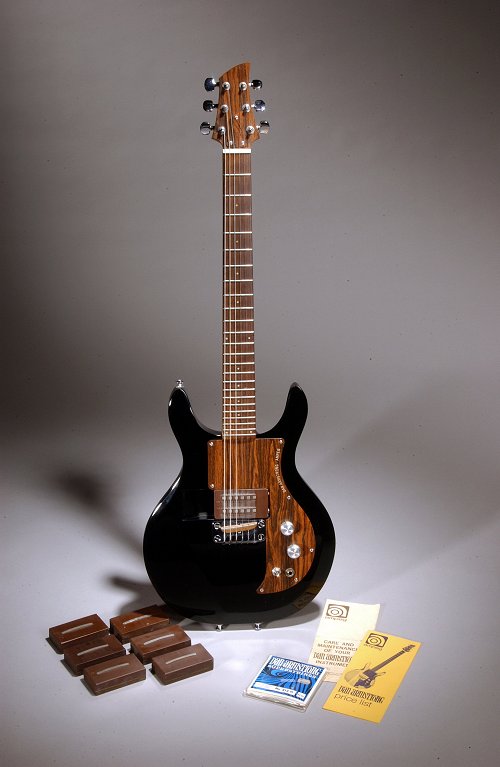
 courtesy of Bill Richardson
courtesy of Bill Richardson
As seen above, a splendid example of a 1969 Black Dan Armstrong guitar with all seven of the available pickups, as well as a set of
Dan Armstrong Superstrings, and some case candy. Notice the straight head screwdriver screws used on the combination bridge/tailpiece
assembly. The earliest Armstrong guitars and basses all employed such screws, changing to the more familiar 'phillips' type screws
sometime in 1970.
Unique to this particular instrument is the use of the 'split' or 'slotted' style Schaller tuners, kind of what is normally
seen on Stratocaster guitars. This is a rarity, as only a small hand full of Armstrong guitars were equipped with such tuners.
Usually the more common 'single-hole' Schallers were used.
The third black Dan Armstrong guitar shown here belongs to Mr. Michael Püttmann who was kind enough to disassemble and
photographed his instrument for our perusal. All photos below are courtesy of Mr. Püttmann.
With the tailpiece and scratchplate removed one can see the channel where the ball end of the strings lie into.
As stated earlier, and as this photo reveals in detail, the earliest models, whether clear or black, were routed with
a smaller channel than the later models.
Also notice the grounding wire near the banana plug coming up from the volume & tone control cavity and laying just
underneath the tailpiece assembly when it is secured to the body. This properly grounds the tailpiece to minimize hum
& noise. Also notice the machining marks in the butyrate as well as the red paint or dye on the soldered joints of the potentiometers.
At upper right, a chrome thumb wheel screw is used to help anchor the pickup down to the guitar's body. This direct
bolt down type attachment of the pickup to the body was, and remains to this day, a totally new & different concept
than what other instruments employ, where the pickup is secured in place on the body with screws and springs. While
it could be argued that springs & screws isolate the pickup better from the guitar, thus preventing feedback squeels
and etc. - a fully potted pickup like the ones Dan designed for the clear acrylic guitars offer the same isolation
while at the same time playing a significant role in achieving excellent sustain.
Also notice the machining marks in the butyrate surrounding the thumb screw as it was bevelled inwards in order
to make the screw flush with the back of the body.
At left you can see the pickup cavity as well as one of the 'banana' type plugs that the interchangeable pickups slide
into. Notice the routing marks in the cavity itself, fairly normal being this is a prototype guitar. Also notice the
neck seen at the left bolted into it's cavity. With both the neck and pickup literally bolted to the body, it allows
for maximum sustaining qualities.
At right, one can again see where the guitar's serial number is hand written on the top side of the neck, in addition
to being stamped into the side. Notice the routed channel slot in the middle of the neck where the adjustable truss rod
lies, as well as a glue stain (seen at the far right of the photo) from when the wooden backfill pieces were glued in.
As on Chad Coulter's black Armstrong guitar Püttmann's black Armstrong also reveals a volume potentiometer made in 1969.
Unlike the tone potentiometer, these volume controls were fully enclosed or sealed.
Although the tone control appears somewhat different on these guitars the numbering scheme employed is still the same.
After 137 the next two numbers reveal the date that the control was made. Notice the red coloring on all the soldered
connections - indicating original equipment with no modifications or replaced parts.
continue
menu
Names and images are TMand © Dan Armstrong / Ampeg. All rights reserved.
All other names and images are TMand © of their respective owners. All rights reserved.
|
| |

